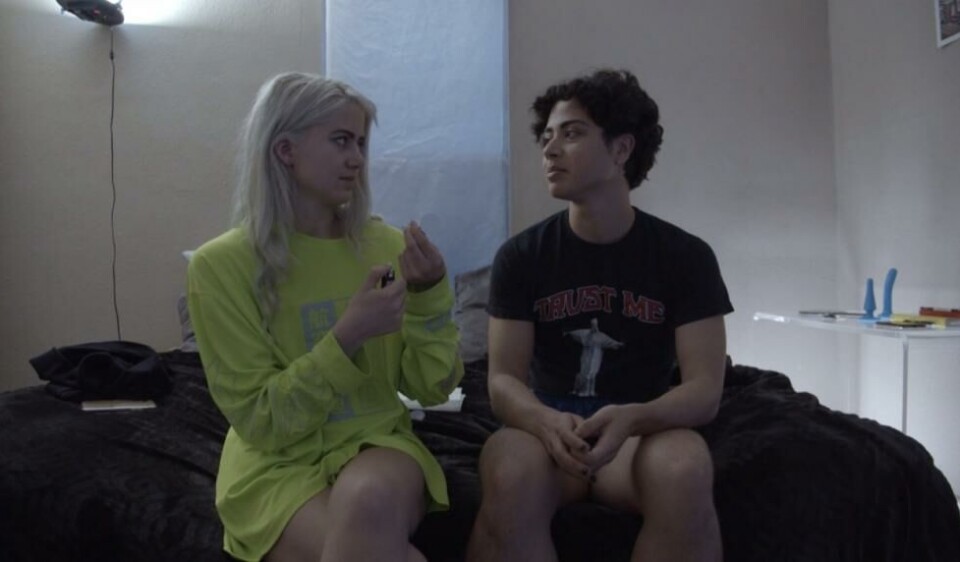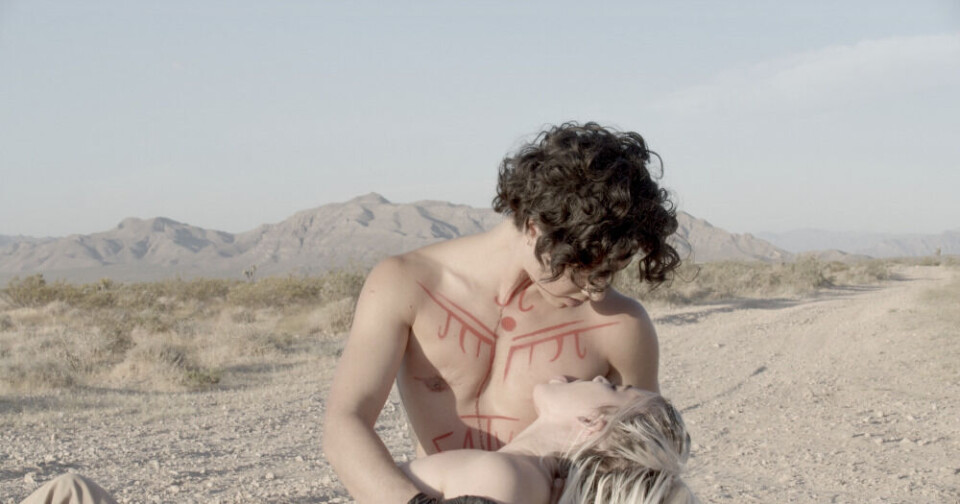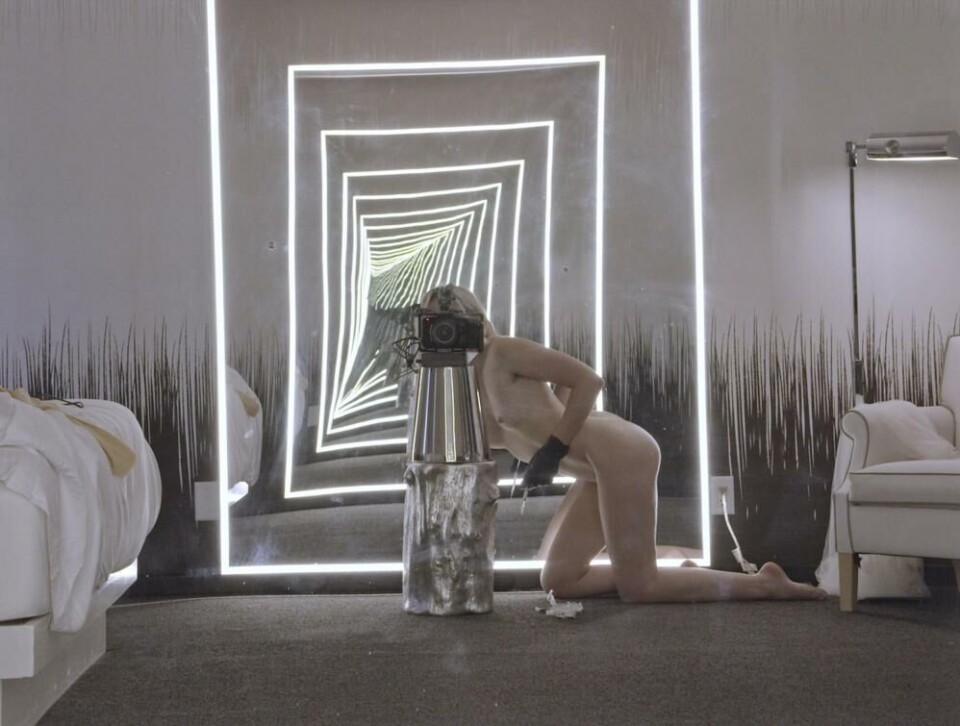
The Owl Or The Moth
In «Seek Bromance», we see our two protagonists playing with and fighting over their perspectives, while searching for words for things that cannot be said. A protagonist transforming into an antagonist, a hero becoming a shapeshifter, or rather: Who's the owl? Who's the moth?
Seek Bromance is the new film/performance by Samira Elagoz, following on from the successful Cock Cock…Who’s There? which
researched the male gaze in relation to Elagoz’ experiences of rape. In 2017, I criticized the work for playing a cat and mouse game with the mechanisms of the male gaze without radically breaking with it. The critique provoked a response by Elagoz claiming, among others, that my position was shaming sexualised images and «contaminated my credibility» as someone who is fighting against sexual violence.
Seek Bromance presents us with a more radical proposal to subvert gender stereotypes, and brings in a ‘stranger’ who comes with answers (and more questions). Elagoz, who in his own words, has made a career out of meeting strangers, gives this role in Seek Bromance to Cade Moga, an artist living in LA, who, at the time of filming, is transitioning. The performance consists of a four hour long video film, including several on-stage commentary interventions by Elagoz, who throughout this process began his own transition.
*
A trans-romance at the end of the world…
A film-performance, docu-fiction, an insta-reality, a sci-fi dystopia,…
A relationship between two transmasculine…
A shared history of performing extreme femininity…
A question: what can masculinity be…
A goodbye to feminine identity…
First image. First edit. Watching Samira and Cade. Two frames separated from one another. Like a Zoom-meeting but in the same room. Cade in front of a window. Behind it, a mountain desert. Samira close to a pale wall, something hanging against it, resembling art. Drawn to the body language, the way Cade sits and listens, their attention. One person talking, the other silent: a combination of stubborn commitment to the moment, while also beginning to withdraw.
A challenge to the transition. Challenge taken.
Watching another lockdown saga: virus talk, social distancing, the world falling apart –– drama. But at least here there will be romance, hours long trans-romance: hot and hip looking romance, hot and hip talking romance. Like a performative equivalent of a four hour long instagram scroll: hip feeling, though not very ‘hot’ feeling.
It’s cold in theaters these days. In the break we shiver while waiting for our turns to the bathroom. Story on pause.
We need to tell stories. It is important to share our stories. We need to listen to the stories we haven’t heard before. Whose story do we tell? What are the stories we tell today? I just posted a story. I can’t find your story. The story is gone.
Another take. There is Cade. Beautiful, complex, deeply layered, exhibitionist Cade. Once glamour model, now fighting against femme-ness, desiring masculinity ‘like a planet close to the sun’. A generous, though not without flaws character who is giving it all: their home, their body, their history, their quest.
A book titled Cosmic Pessimism, as if being an unwitting testimony, appears shortly on the screen. Cosmic pessimism and cosmic pain. Our gendered pain. Our shared gendered pain. Fragmented pain. The process of gendering: complex, fluid, impossible to trace. Fighting for, with and against gender. Doing and undoing gender. Nothing ever fixed.
«I am not a man I am not a woman I am not heterosexual I am not homosexual I am not bisexual. I am a dissident of the sex-gender system. I am the multiplicity of the cosmos trapped in a binary political and epistemological system, shouting in front of you. I am a Uranian confined inside the limits of techno-scientific capitalism.»* Hi Paul B. Preciado. Thinking of you.
Testosteron is a drug, it’s addictive, it’s empowering, Cade says.

Needles give. Needles take. Cade gives the needle. Cade drinks the blood. Cade dances around like a wise fool in the desert. Presented as a mentor, though now feeling more like our muse. Earlier on, we see Cade sitting on a bed. On their T-Shirt, Jezus Christ with the words «Trust me» on it. Your blood tastes good, Cade says. Vampire Cade, talking tongues, talking codes, making it more bearable to sit this through.
The project is described as a treesome between two people and the camera, but the camera gets in the way. The camera, Cade laughs, is a sin. A sin with two sides. Later in the background, we hear Cade asking if the reason of having sex together is because of desire or because of the project. What is good sex for you, Samira asks.
«Most people want to fuck the thing they desire. I want to become the thing I desire.» Everything Cade says is irresistibly quotable. In this film however, no fucking. Instead a lot of talking about fucking and the rape experience and also some soft erotic pictures, the kinds you might see on instagram but with exposed nipples on the otherwise censured breasts. Free the nipple, but the nipple will never be free.
Cade pacing around, talking about an aversion towards glamour models (their past) and how pornostars should be seen as brave (or was it honest), because instead of being frozen in a world of adoration, they go for (and give) the real thing –– satisfaction. Then later (or was it before), an awkward moment, Samira filming deepthroating his fingers, while Cade walks in. A confused Cade off camera trying to understand. Samira’s close up face on camera answering that he was just trying something out.
A while ago, I read on socials that the Seek Bromance project was tainted with issues of consent. Institutions, one of which I think off very highly, were apparently not responding. So the call was to not show up and support the harmed individual by following them on instagram.
The art and the artists are separate. The art and the artist are the same.

A rite of passage in the desert. A deserted Las Vegas. A hotel room without soul. A cocktail with not-real strawberries tasting real.
Cade mentions Lilith, the vampire, then tells a story about the owl and the moth. There is a type of moth, Cade says, who when the wings are placed next to on another ressemble the eyes of their predator, the owl: ‘To resemble what you are afraid of in order to protect yourself’ ––– a cruel faith. Who’s the owl? Who’s the moth?
Not to be afraid. But to become something else….
We hear the word intimacy and trigger as if on repeat. It’s not going well. Sentences like: «I want to heal. I also want to heal. I cannot heal you.“
«It touched me a lot, although I feel somewhat mixed about the narcissism,» a friend later says. A couple of years ago I learnt that narcissism is no longer an argument of art critique. I was told that Karl Ove Knausgård is a narcissist and that, even if we might hate him, we love him. We need to trust our love. Narcissism: an argument out of the window.
Cade’s hands sticking words on a window, sentences that read: «You remind me of someone I invented. You remind me of someone I wanted to destroy.»
Mirrors.
Narcissism yields narcissism, growing rizom-like, infiltrating the utopia of the pharmapornographic era*. As if we are already beyond.
The performance is presented as a «real story».
The performance is presented by the one and only author telling us this real story. As if not trusting that we cannot see it for ourselves. As if needing to make it more real by saying it live and in person, as if not trusting it is real enough. Paranoid singular authorship: «come to my office, I will explain’ you how it went.»
To intentionally edit out, to intentionally misquote, to intentionally shape the story so it fits my own. Then the ‘as if’ intentions matter. Intentions erased.
A dedicated artist –– a good story.
My life is a performance, Samira-on-screen says. When I fan something, I become it. Later Cade moves around, talking about making a fetish out of their own transition. To fetichise your own transition: a provocative thought, while also comforting in its acceleration. All our experiences and every corner of our identity –– all potential sources for the fetich to emerge. Go to the temple, find the source, drink and get wasted.
SATYR written in red paint on Cade’s chest. Samira asking Cade if this is how they feel. Cade answering something about the word satire and the need to make a satire of yourself before others get a chance.
One of the last images, a text saying that Cade is non-binary now. An invitation to be respectful and to please use the right pronouns.
This is not a transition story, Samira says when introducing the movie on stage. Then showing that story. Like a surrealist statement without the surrealism. Like a love letter without a lover. Like a strawberry cocktail without strawberries. All of it, so timely.
Footnote:
*Paul B. Preciado (born Beatriz Preciado, Spain) is a writer, philosopher, curator, and one of the leading thinkers in the study of gender and sexual politics. The quote in this review comes from An Apartment on Uranus (2020). Preciado is probably best know for Testo Junkie: Sex, Drugs, and Biopolitics in the Pharmacopornograhic Era (2008), a book describing the writer’s experience of taking Testogel as a political and performative act while intertwining it with critical perspectives on pharmaceuticals and pornography.
(Published December 16th 2022)
Related article in Norsk Shakespearetidsskrift:
Valbrog Frøysnes: Les meg! Anmedelse og kommentar til Samira Elagoz’ Cock Cock… Who’s there? 2018
https://shakespearetidsskrift.no/2018/03/les-meg










